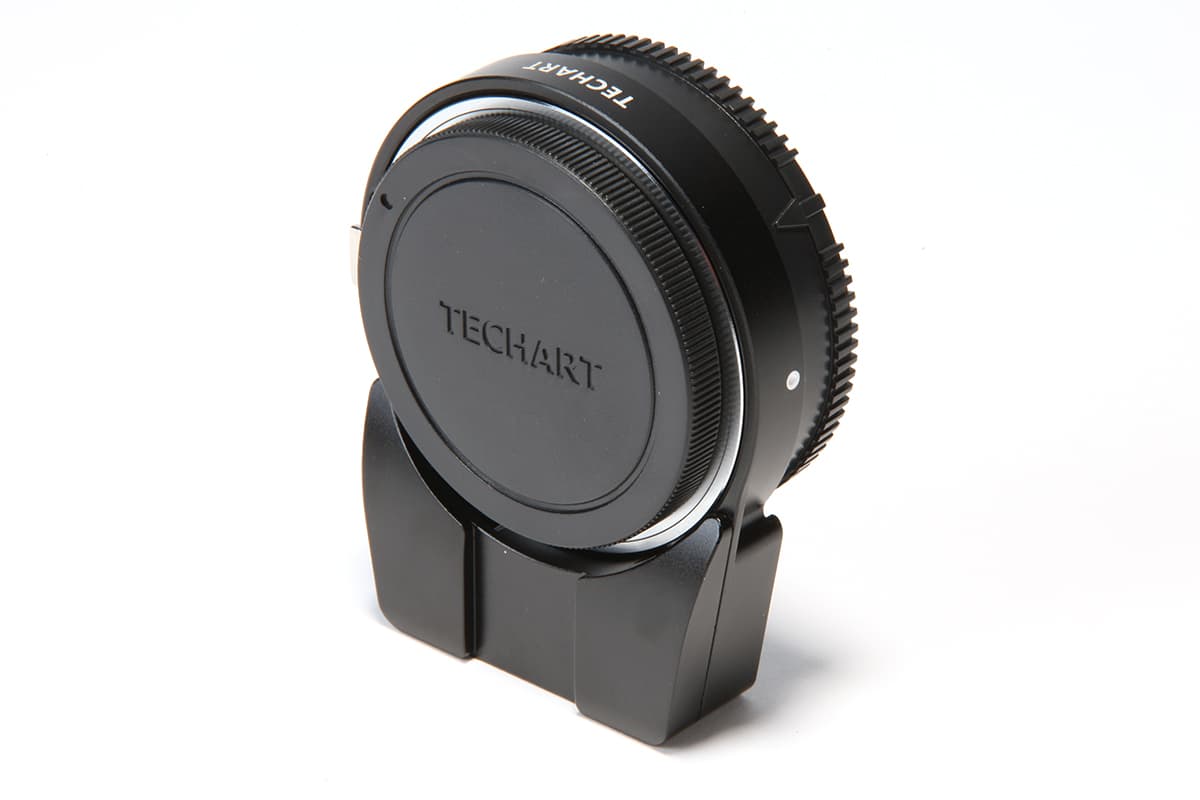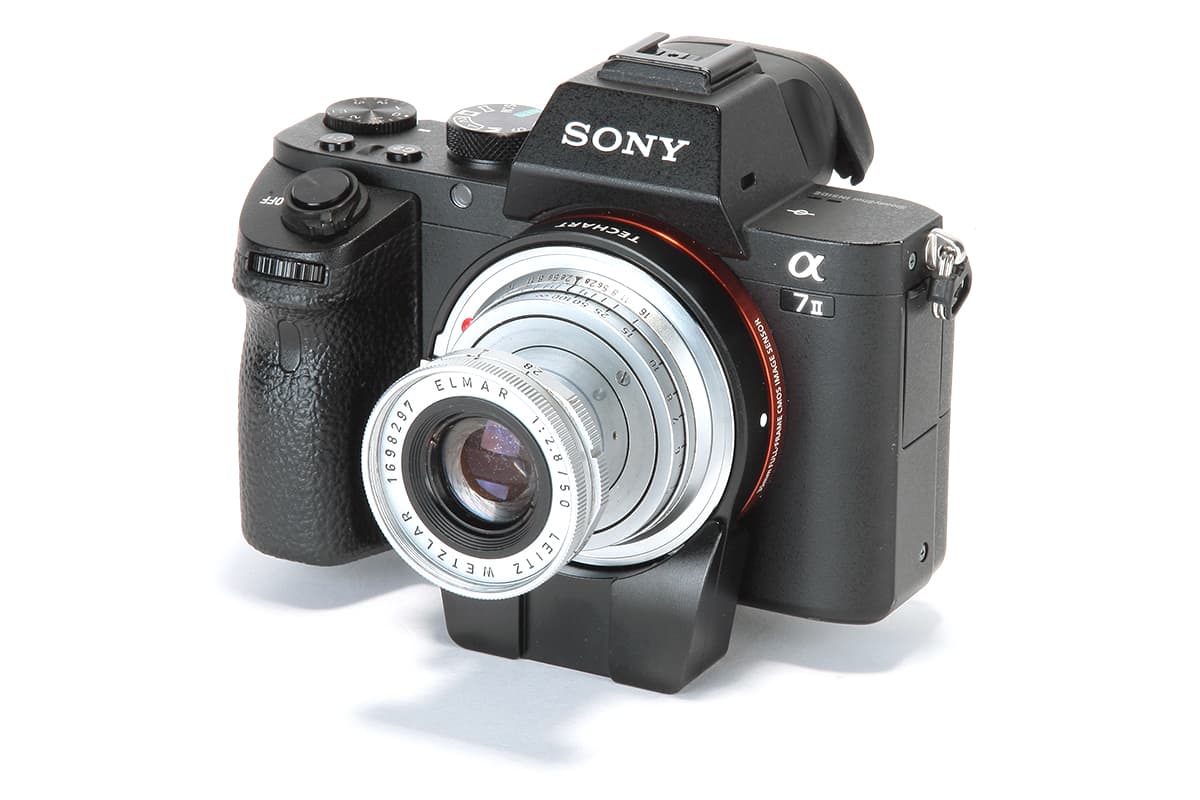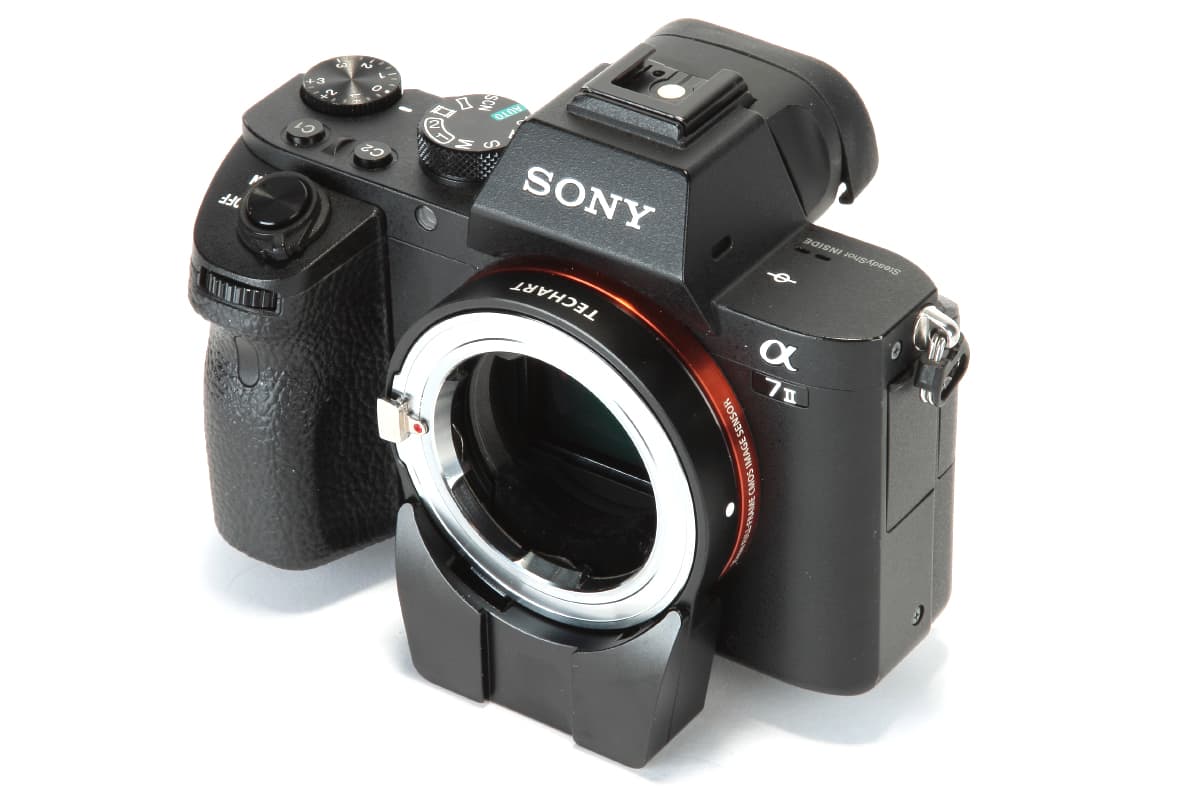Techart PRO Leica M – Sony E autofocus adapter review: Introduction
At a glance:
- £425
- Fits Sony E-mount cameras
- Accepts Leica M-mount lenses
- Built-in Bluetooth for programming from a smartphone
When mirrorless cameras first appeared, relatively few lenses were available to fit them. This quickly spawned a minor industry exploiting the new system’s short mount-to-sensor distances, building adapters that allowed the use of old manual focus lenses. Perhaps surprisingly, the use of mount adapters with mirrorless cameras is still very popular, even though native lens ranges have built up to the point where most options are covered. If anything, the introduction of Sony’s Alpha 7 range has spurred on their use even further, as the full-frame sensor allows old 35mm-format lenses to be used without any field of view crop.

Shooting with manual lenses, however, does bring some inconveniences – most obviously the lack of autofocus. But a Chinese firm called Guangzhou Nitian Electronic Co Ltd has come up with an ingenious solution. Its Techart PRO autofocus adapter fits on to Sony E-mount bodies and has a Leica M mount for attaching lenses. But the clever bit is that the mount can move backwards and forwards by 4.5mm, driven by a small built-in motor powered from, and controlled by, the camera body. This allows autofocus with manual lenses.
Now, you might think that the usefulness of this device is limited, as M-mount lenses are relatively rare and expensive. But the next clever bit is that almost any old manual focus SLR lens can fit on to the Leica M using an additional mount adapter. So if you have a collection of nice old lenses from a long-dead 35mm SLR system sitting gathering dust, this adapter potentially lets you use them all with autofocus on an Alpha 7 body. What’s more, it’s claimed to work with lenses weighing up to 700g, which should cover all but the largest optics.
There is a catch though – the adapter relies on the camera’s phase detection system to function. This means that you’ll need to use either an Alpha 7 II or Alpha 7R II for it to work. Users of the first-generation models, or the Alpha 7S II, are out of luck, while the only APS-C mount body expected to be compatible is the £1,500 Alpha 6500.
I tested the Techart PRO on the Sony Alpha 7 II, with its 24-million-pixel full-frame sensor. While I tried out one M-mount lens – an old 50mm f/2.8 collapsible Elmar – my main aim was to see how well it would work with my collection of old Olympus OM-mount lenses. Without further ado, let’s find out.
Techart PRO Leica M – Sony E autofocus adapter review: Design and build

When you first take the Techart PRO adapter out of its box, it’s difficult to believe that such a small device can do what it claims. The main mount adapter section is (necessarily) less than 10mm thick, with the AF motor and electronics all contained in a bulbous housing underneath. This protrudes about 8mm beneath the base of the camera, which means it’s likely to interfere with most tripod quick-release plates. But if you’re working from a tripod, then you may as well use manual focus anyway.

There’s nothing to fault in terms of build quality, with the smoothly finished black metal body inspiring confidence in its durability. Both mounts are precisely engineered, with the adapter fitting firmly to the camera without a hint of play, while M-mount lenses and adapters click solidly into place. The lens release tab, while flat and untextured, and with only short travel, feels built to last too.

Turn the camera on and the adapter springs to life, extending its silver-coloured inner barrel forward by 4mm, then back again as it goes through a self-calibration process. Even with relatively heavy, bulky lenses there’s little sign of any wobble or tilt. One crucial point, however, is that Alpha 7 II owners may need to update their camera’s firmware to support phase detection AF with third-party lenses. Without this, the adapter will simply whirr back and forth helplessly, exactly as it did at first with my test camera, before I worked out how to fix it.
Techart PRO Leica M – Sony E autofocus adapter review: Bluetooth programmability
The least conventional aspect of this device is its Bluetooth programmability. The basic idea makes sense: because the adapter communicates electronically with the camera it can report lens information for inclusion in EXIF data, with the focal length also allowing the in-body image stabilisation work correctly. But rather than maintaining a connection to a smartphone and letting you specify the lens in use via an app, it works more obtusely.

To activate the Bluetooth, you first change the aperture setting to f/90, then press the shutter button and turn off the camera. You can then pair your phone using the free Techart app, and program in information for your lenses. Each gets associated with an aperture value that you’ll set on the camera; for example, at the adapter’s factory settings f/25 is used for a 50mm f/1.4. When you change lenses, selecting the corresponding aperture and pressing the shutter button updates the lens information passed to the camera.
This means you don’t need to carry a phone around to select a new lens each time you switch, but do have to remember which aperture setting corresponds to each lens. Another snag is that at the time of writing, the app is only available for Android and in Chinese, and I couldn’t persuade it to program in all the lenses I wanted to use. In the end I decided to set the Alpha 7 II’s IS system for manual focal-length configuration via the C3 button instead.
Techart PRO Leica M – Sony E autofocus adapter review: Performance
Of course the big question with such a device is whether it actually works? To find out, I tested it with lenses ranging from an Olympus OM 24mm f/2.8 wideangle to a Tamron SP 500mm f/8 mirror lens. In short, yes it works – although with some limitations.
Most importantly, its 4.5mm focusing travel is only really sufficient for lenses of around 50mm or wider; with longer telephotos the range of AF adjustment using the adapter alone becomes very limited. For instance, with a 135mm lens the adapter only allows focusing as close as 4.2m, when the lens itself is set to infinity. But that’s not necessarily a complete disaster; you can still focus the lens manually to approximate the correct distance and then use the autofocus to fine-tune. It’s not like using a proper AF lens, but it works.

With long lenses it’s necessary to set approximately the correct focus manually first. Sony Alpha 7 II, Tamron SP 500mm f/8 mirror, 1/320sec @ f/8, ISO 160
Autofocus is unexpectedly fast; indeed with small lenses it felt more responsive than some of Sony’s own budget primes such as the FE 50mm f/1.8. Focusing slows down in low light, but that’s only to be expected. The set aperture also has an effect on autofocus, because M-mount lenses stop the diaphragm down directly as the aperture ring is turned, and most mount adapters for mirrorless cameras force the lens to work in the same way.

Here, the Techart PRO had no problem accurately focusing my Olympus OM 55mm f/1.2 on the Sony Alpha 7 II. Sony Alpha 7 II, 1/60sec at f/1.2, ISO 800
But while most DSLRs can’t autofocus at effective apertures smaller than f/6.3 or thereabouts, I found that on the Alpha 7 II autofocus continues to work pretty well when the lens is stopped down as far as f/11. Indeed the camera was quite happy autofocusing my 500mm f/8 mirror lens, which is some achievement. But if you wish to use even smaller apertures such as f/16 – still a perfectly sensible working aperture on full frame – it will stop functioning reliably.

Autofocus worked perfectly here, despite the lens being stopped down for depth of field. Sony Alpha 7 II, Olympus OM 50mm f/1.4, 1/125sec at f/8, ISO 80
Focusing isn’t entirely silent; instead the adapter’s built-in motor buzzes away quietly to itself, especially if the camera is hunting for focus. To be fair, it’s not hugely obtrusive, but we’ve become so used to near-silent focusing on modern CSC lenses that it still stands out quite noticeably. Then again, in situations when you need quiet operation, you can simply revert to manual focus. Disconcertingly this option is greyed out in the camera’s menus, but it can still be engaged by configuring the AF/MF button on the camera’s back to its ‘toggle’ setting.

Accurate autofocus makes it easier to use old fast primes. Sony Alpha 7 II, Olympus OM 50mm f/1.4, 1/800sec @ f/1.4, ISO 200
Continuous autofocus is supported for stills shooting, and while this works, don’t expect miracles. It’s not going to be the tool of choice for fast-moving subjects like sports and wildlife, but for portraits where the subject is moving relatively slowly, it should be able to keep up just fine. In video mode, however, continuous AF has sensibly been disabled.

The Techart Pro enabled the A7 II to accurately autofocus my Tamron SP 500mm f/8 mirror lens; this image is cropped to around 900mm equivalent. Sony Alpha 7 II, 1/640sec, f/8, ISO 800
One notable strong point of the Techart PRO adapter is its autofocus accuracy. Because it’s working with the camera’s on-chip phase detection rather than using a separate light path, it’s inherently accurate and not subject to the kind of systematic front or back focus problems that can plague DSLRs. I found it even worked pretty reliably with my Olympus OM 55mm f/1.2, a lens that’s decidedly hazy wide open due to high levels of spherical aberration, and usually quite difficult to focus. The AF point can also be moved around the central area of the frame to some degree, although not to anywhere near the same extent as with contrast-detection lenses.
One useful property of this adapter involves close focusing. If you set the lens to its usual minimum distance, it’s possible to focus even closer by adding in the adapter’s movements – in effect like adding a short extension tube. With a standard 50mm prime, this can buy a few useful extra inches of close-up ability.

The adapter extends the lens’s close-focusing ability. Sony Alpha 7 II, Olympus OM 50mm f/1.4, 1/250sec, ISO 800
On a related note, it’s also important to appreciate the possible impact of using the adapter on close-up shots. Most old lenses employed unit focus designs, moving the entire optical unit back and forth to focus. In such cases, the adapter is essentially doing the same thing, so there’s no negative impact on image quality. But some lens designs use a floating focus system to give better image quality at close distances, and in this case it’s better to use the lens’s own manual focusing mechanism.
Techart PRO Leica M – Sony E autofocus adapter review: Verdict
Overall I have to say I’ve been impressed by the Techart PRO adapter. On the whole it works well, just as long as you’re aware of its weaknesses (particularly with telephoto lenses) and how to get around them. Crucially though it focuses fast enough to be worth using, and is not so bulky that it gets in the way. Because of this, it transforms the experience of working with the Alpha 7 II.

Indeed the Techart PRO turns the Alpha 7 II into the camera that I, for one, have always wanted it to be. It allows you to carry around this compact full-frame body with a selection of small, high-quality primes and use them with autofocus. Sony’s own FE lens range, in contrast, includes only a few compact primes, being dominated by optically stunning, but huge and expensive f/1.4 lenses. At £425 the Techart Pro is probably too expensive for most photographers to consider building a new system around, but if you already have an appropriate lens set to hand, it makes the Alpha 7 II an even more compelling vehicle for resurrecting them.







